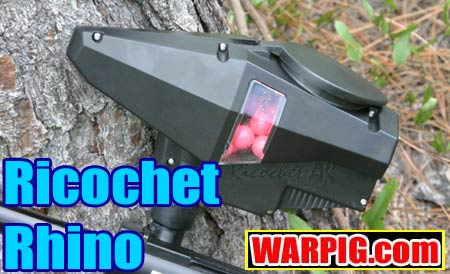  |
|
|
|
|
|
|
  |
|
|
|
|
|
|

What
do you think?
|

Ricochet Rhino by Bill Mills - September 2003 With the release of the Ricochet 2K, Ricochet development changed the loader scene in tournament paintball – there was no longer just one brand of agitating loader on the fields in the US. Since then the loader market has blossomed with new choices for players, many of these options focusing on faster, more reliable loading speeds. This usually also means a correspondingly higher price tag.
From the outside, the Rhino looks very much like a Ricochet AK loader. It has the same angled body designed to promote ball deflection rather than breakage. In the left side is the same window to allow a right-handed player an immediate view of how much paint they have left in the hopper. The feedneck has Ricochet’s exclusive friction o-ring system designed to give the loader a snug fit in vertical feed necks. On the rear is a single push button to turn the loader on and off, as well as an LED to indicate power status. On the inside, however things are different. Ricochet’s AK and 2K loaders feature an agitator with 4 arms made of thick monofilament trimmer line. A bend sensor in the feed neck actuates the agitator for a few seconds each time a ball feeds, to ensure that the paintballs do not jam in the loader. The Ricochet Rhino is much simpler.
The Rhino’s agitator is a hemisphere, about an inch across, with a pair of monofilament arms sticking out of it, and there are no sensors. Since the loader has no way to “know” when the paint might need agitating, it takes a simpler approach to the jamming paint problem – agitate it continuously. When the Rhino is turned on, its agitator slowly revolves at roughly .8 revolutions per second (48 rpm) continuously, with a quiet hum of the motor and gears. This approach may not be as battery efficient as agitating only when needed, but it means that the Ricochet Rhino can deliver agitated loading for about half the price of the Ricochet 2K, and about 2/3 the price of an AK. For younger players on a limited budget that cost differential can be the difference between getting an agitated loader or playing “shoot and shake” to un-jam their hopper. Like Ricochet’s other hoppers, the Rhino is powered by a single 9-volt battery. A sliding hatch in the rear of the loader provides drop in access for changing the battery, which is held in place by pressure from its spring loaded contact clips.
It should be noted however, that when the 98’s Response Trigger was activated, it was possible to outshoot the Rhino, especially when firing bursts of 5 of more shots. The same held true for using the Rhino on a Matrix LCD, and became more noticeable with the ability to sustain high rates of fire. For the budget conscious player wanting
better loader performance to keep up with their blowback semi-auto, the
Ricochet Rhino represents a new option, while for more experienced players
shooting electronic or reactive triggered paintguns, Ricochet’s high end
models would represent a better choice.
|
| Copyright © 1992-2019
Corinthian Media Services. WARPIG's webmasters can be reached through our feedback form. All articles and images are copyrighted and may not be redistributed without the written permission of their original creators and Corinthian Media Services. The WARPIG paintball page is a collection of information and pointers to sources from around the internet and other locations. As such, Corinthian Media Services makes no claims to the trustworthiness or reliability of said information. The information contained in, and referenced by WARPIG, should not be used as a substitute for safety information from trained professionals in the paintball industry. |